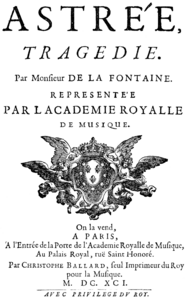Astrée
| Opera dates | |
|---|---|
| Title: | Astrée |

Title page of the libretto, Paris 1691 |
|
| Shape: | Tragédie lyrique in a prologue and three acts |
| Original language: | French |
| Music: | Pascal Collasse |
| Libretto : | Jean de La Fontaine |
| Literary source: | L'Astrée by Honoré d'Urfé |
| Premiere: | November 28, 1691 |
| Place of premiere: | Paris, Académie Royale de musique |
| people | |
Astrée is the title of a tragédie lyrique in a prologue and three acts based on motifs from Honoré d'Urfé 's novel of the same name . The music for the libretto by Jean de La Fontaine was composed by Pascal Collasse . The premiere took place on November 28, 1691 in the Académie Royale de musique in Paris.
action
prolog
The god Apollo has withdrawn from Mars , the god of war, to the area around the royal castle of Marly and has the shepherds found there present the story of Céladon and Astrée to the Paris audience.
first act
Sémire gave the shepherdess Astrée unnoticed various love potions so that she would become estranged from her lover Céladon and fall in love with Sémire. Astrée actually believes that Céladon is cheating on her with the shepherdess Aminte and never wants to see Céladon again. Céladon then vows to commit suicide. At the big Druid New Year festival, Astrée and everyone present learn that Céladon has drowned herself in the nearby river. Shaken, Astrée now wants to take her own life.
Second act
The half-dead Céladon was discovered by the princess Galatée on the river bank, who immediately fell in love with him. Céladon rejects her courtship and wants to build a temple for his only love, Astrée, in the nearby forest. The suddenly appearing sorceress Ismene prophesies the end of his suffering, transforms the garden of the Princess Galatée into a forest and creates the temple through her magic arts.
Third act
Céladon has followed Astrée roaming through the forest and finds her lying in a magical sleep at the dangerous “source of true love”, which also seizes him. When both wake up from this magical sleep, the old affection returns and they fall reconciled into each other's arms. Princess Galatée renounces Céladon and a shepherdess ballet ends the opera.
Work history
For the first act, de La Fontaine Part I, Book 1 of d'Urfé's story L'Astrée served as a template, for the second act additionally books 2 and 5 from Part I and Book 5 from Part II. For the third act, de used La Fontaine, the last four books from Part V. De La Fontaine partly followed the template exactly, partly he deviated from it in details and larger features. The prologue is entirely from de La Fontaine.
The opera saw only six performances. Music and libretto were quickly the subject of numerous mockery verses. Astrée is the second libretto de La Fontaine after Daphné (1674). A third, on the subject of the Galathea myth, he left unfinished.
literature
- Astrée. In: Félix Clément, Pierre Larousse : Dictionnaire des Opéras , Paris 1881 ( digitized version )
- Walther Paul Fischer: The literary relations between La Fontaine and the "Astrée" of Honoré d'Urfé. Philadelphia 1913 ( digitized )
Web links
- Digitization of the score (1691, manuscript) in the Bibliothèque nationale de France
- Digitization of the score (1691, different manuscript) in the Bibliothèque nationale de France
- Digitized of the libretto in the Œuvres complètes de La Fontaine (Paris 1872) in the Internet Archive
Individual evidence
- ↑ Vocal range designations according to detailed information on the digitized score at Gallica .